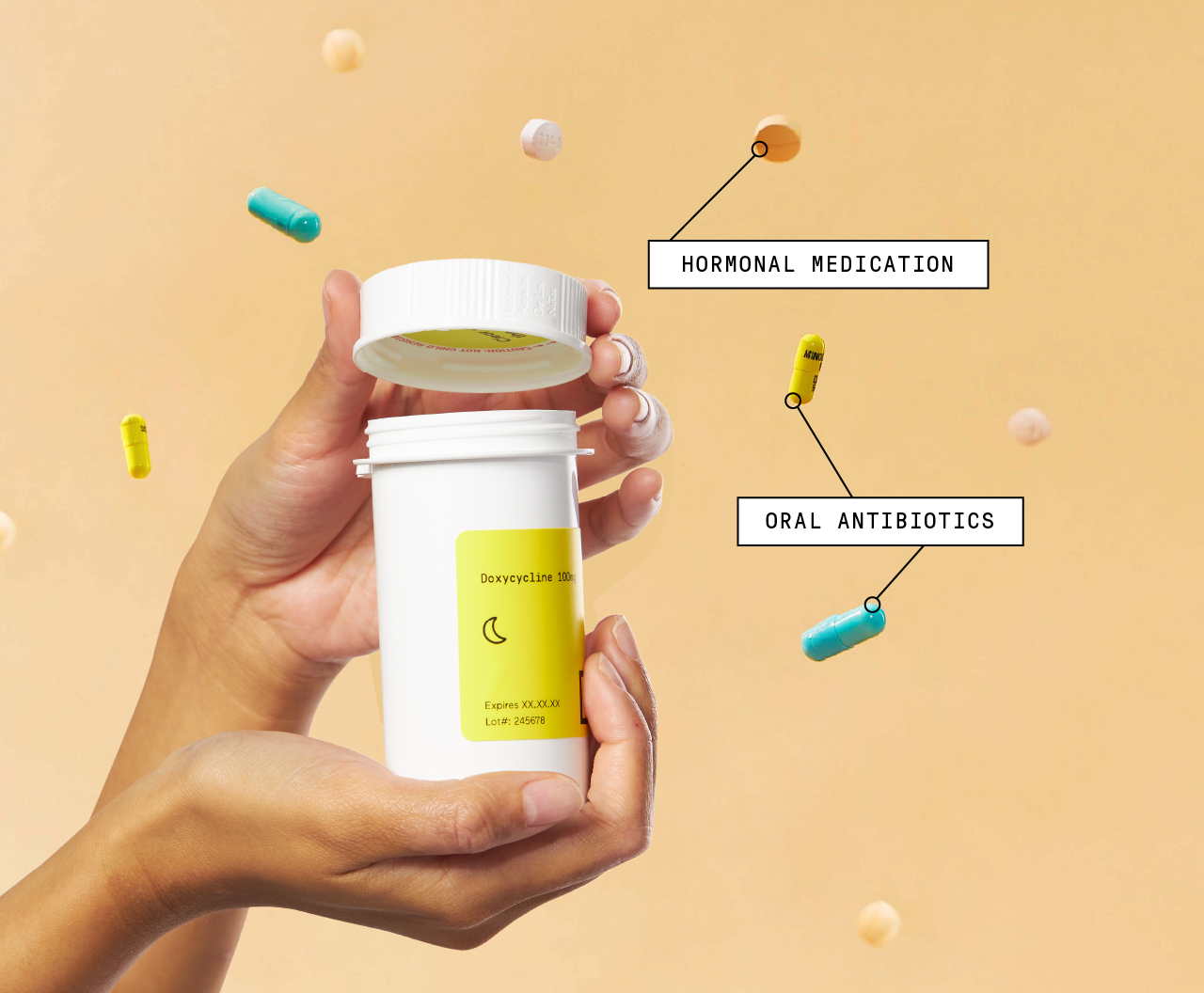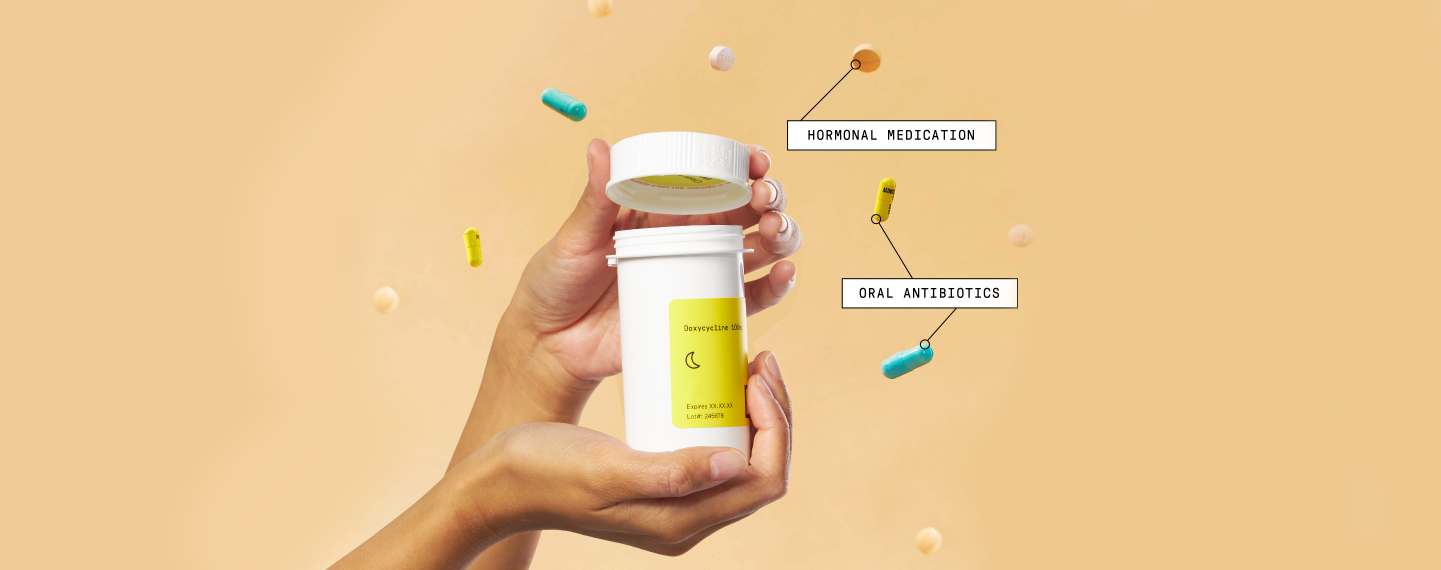Apostrophe Treatments
Oral Acne Meds: An Overview


SHARE
Apostrophe Treatments
Oral Acne Meds: An Overview
Medically reviewed by Aimee Paik, MD
Written by Apostrophe Team
Last updated 8/4/2024
What do you think of when you think about acne treatments? Cleansers, creams, and ointments? Maybe the never-ending aisle of acne products at the drugstore? Most people don’t leap to oral medicines when considering how to tackle their acne, but these treatments can play an important role in handling inflamed skin and addressing the hormones that are causing your skin concerns. There are a lot of different options when it comes to oral medications for acne, so we’re here to explain a few of the most common and how they might be able to help you!
Antibiotics
Antibiotics can be an invaluable tool in your battle against acne. They are typically prescribed for a short period of time (often three to six months) to help give your skin an initial head start and give other topical or oral treatments a chance to kick in. Contrary to their name, antibiotics primarily work to treat acne by reducing inflammation in the skin. Killing acne-causing bacteria is a secondary effect. All antibiotics can cause gastrointestinal side effects (the result of antibiotics affecting the good bacteria in your gut) as well as other, less common, side effects like photosensitivity or dizziness. Be sure to talk to your dermatology provider if you experience any adverse side effects like these so they can prescribe the right treatment for you!
Apostrophe pharmacy is open!
Apostrophe pharmacy is now dispensing topical and oral medications! Dr. Aimee Paik has selected these medications based on her experience and knowledge as a board-certified dermatologist. Here are the antibiotics she believes to be the safest and most effective against acne:
Doxycycline and minocycline – Doxycycline and minocycline are both classified as a tetracyclines (more on tetracyclines below) and are both commonly prescribed for acne and rosacea. They primarily target inflammation and also reduce the amount of acne-causing bacteria on the skin. Dr. Aimee Paik notes the primary difference between the two drugs are their side effects: “Doxycycline tends to cause more photosensitivity while minocycline more commonly causes hives and initial dizziness.” Let your provider know about any negative side effects so they can prescribe the right treatment for you!
Cephalexin - Cephalexin is part of a group of antibiotics called cephalosporins. It is not always the first choice when treating acne, but research on its efficacy has shown it to be a good option. In one study of 93 patients, 4% saw their acne completely clear and 45% were much improved. This medication is also useful when a patient has a tetracycline allergy that prevents them from taking doxycycline or minocycline.
We decided not to kick it old school…
There are a couple antibiotics that you may have heard of that used to be commonly prescribed for acne, but no longer are.
Tetracycline – The class of antibiotics called tetracyclines also includes minocycline and doxycycline (why did science decide to name both this antibiotic and the entire class of antibiotics the same thing? We don’t know but we think it’s very confusing). It’s important to note that people who are pregnant or nursing cannot take this class of antibiotics since it can cause birth defects. Doctors used to often prescribe the drug tetracycline for patients whose acne is moderate to severe and dosages can vary based on the individual needs of the patient. However, they typically do not prescribe it anymore because it has cumbersome food restrictions that are not present for doxycycline and minocycline.
Erythromycin – Erythromycin is in a class of antibiotics called “macrolides” that also includes azithromycin. Doctors used to use it to treat acne more often in the past, but with newer drugs on the market, erythromycin’s use has become more restricted. There is a higher risk of antibiotic resistance with this drug and limited data to support its effectiveness against acne. For these reasons, doctors typically look at other options before prescribing this antibiotic.
Anti-androgens
Anti-androgens are types of drugs that affect the balance of your hormones by suppressing the activity of androgens like testosterone. While the role testosterone plays in the development of acne isn’t completely understood, researchers believe increased testosterone can trigger increased sebum production which leads to clogged pores. While anti-androgens aren't typically prescribed to men because of their anti-androgenic activity, they can be a useful treatment for women who struggle with period-related breakouts or hormonal adult acne.
Spironolactone – Originally used to treat high blood pressure, more and more dermatologists have been prescribing spironolactone to treat hormonal acne with great success. Spironolactone works by “outcompeting” androgens for their receptors so the androgens can’t bind, which in turn decreases your skin’s sebum production. With growing concerns in the medical community about antibiotic resistance, spironolactone represents a safe and effective long-term treatment option for treating adult acne. Best of all, you can get spironolactone online through the Apostrophe platform!
Contraceptives – Like spironolactone, many birth control pills decrease the circulation of androgens in your body, thereby decreasing sebum production. One 2018 review concluded that pills with a combination of estrogen and any type of progestin can be effective against inflammatory and non-inflammatory acne. The dermatology providers on our platform do not prescribe contraceptives, but may suggest you talk to your gynecologist or primary care physician for a prescription if they feel you may benefit from taking a contraceptive pill.
Oral medications can play an important role in your battle against acne. The providers on the Apostrophe platform often prescribe them in tandem with your topical treatments so you can tackle your acne from both the outside and the inside and put your best face forward. Get started on your skin care journey and get your acne prescription online through Apostrophe!
Sources:
1. Anti-androgen therapy. Anti-androgen therapy | DermNet NZ. https://www.dermnetnz.org/topics/anti-androgen-therapy/#spiro. Accessed June 14, 2019. 2. Antibiotics for acne. Antibiotics for acne | DermNet NZ. https://www.dermnetnz.org/topics/antibiotics-for-acne/. Accessed June 14, 2019. 3. Birth Control for Acne: Brands to Try, How It Works, and More. Healthline. https://www.healthline.com/health/best-birth-control-for-acne#what-the-research-says. Accessed June 14, 2019. 4. Bosanac SS, Trivedi M, Clark AK, Sivamani RK, Larsen LN. Progestins and acne vulgaris: a review. Dermatology Online Journal. 2018;24(5):1-6. https://escholarship.org/uc/item/6wm945xf. Accessed June 14, 2019. 5. Erythromycin. Erythromycin | DermNet NZ. https://www.dermnetnz.org/topics/erythromycin/. Accessed June 14, 2019. 6. Fenner JA, Wiss K, Levin NA. Oral Cephalexin for Acne Vulgaris: Clinical Experience with 93 Patients. Pediatric Dermatology. 2008;25(2):179-183. https://www.ncbi.nlm.nih.gov/pubmed/18429774. Accessed June 14, 2019. 7. Goulden V, Glass D, Cunliffe WJ. Safety of long‐term high‐dose minocycline in the treatment of acne. British Journal of Dermatology. 1996;134(4):693-695. https://onlinelibrary.wiley.com/doi/abs/10.1111/j.1365-2133.1996.tb06972.x. Accessed June 14, 2019. 8. Isotretinoin. Isotretinoin | DermNet NZ. https://www.dermnetnz.org/topics/isotretinoin/. Accessed June 14, 2019. 9. Palmer A. Why Oral Tetracycline Might Be the Answer to Your Acne Problems. Verywell Health. https://www.verywellhealth.com/oral-tetracycline-15840. Published November 21, 2018. Accessed June 14, 2019. 10. Practice Management Center. Systemic antibiotics: Recommendations | American Academy of Dermatology. https://www.aad.org/practicecenter/quality/clinical-guidelines/acne/systemic-antibiotics. Accessed June 14, 2019. 11. https://www.ncbi.nlm.nih.gov/pubmed/21413648 12. https://www.dermnetnz.org/topics/sebum/ 13. https://www.jaad.org/article/S0190-9622(83)80260-6/pdf 14. Steinberger E, Rodriguez-Rigau L, Smith K, Held B. The menstrual cycle and plasma testosterone levels in women with acne. Journal of the American Academy of Dermatology. 1981;4(1):54-58. 15. Tetracycline. Tetracycline | DermNet NZ.
Like what you just read? Sign up for our email list to get the scoop on skincare science delivered straight to your inbox.

Deep Dives
A dermatologist shares his thoughts on the recent studies about benzoyl peroxide and benzene.
Read More
Education
What is milia?
What is milia? Today, we’re jumping into one type of bump that you may have heard about most commonly in infants — milia.
Read More
Education
Best moisturizer for acne-prone skin
If you have combination acne-prone skin, figuring out which moisturizer is best for your skin might be tough. In this guide, we break down the best moisturizer for combination, acne-prone skin.
Read More